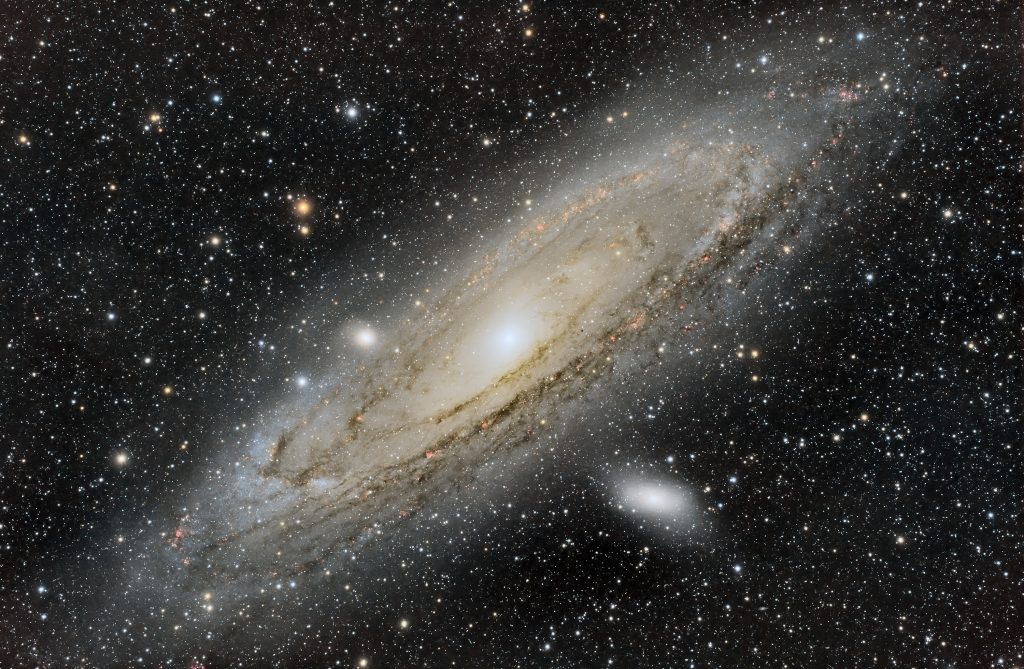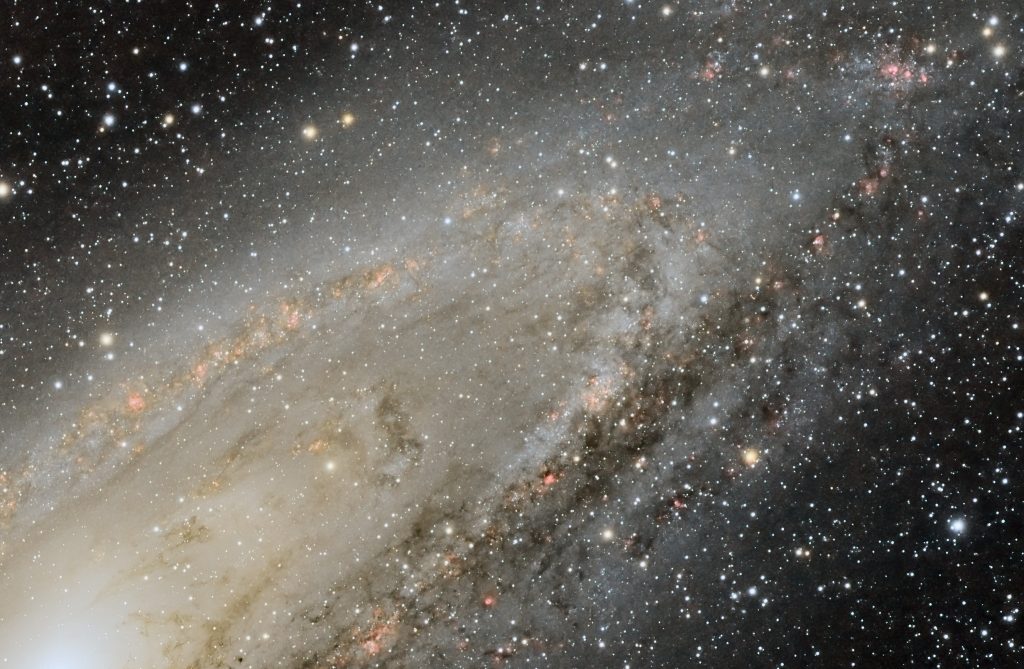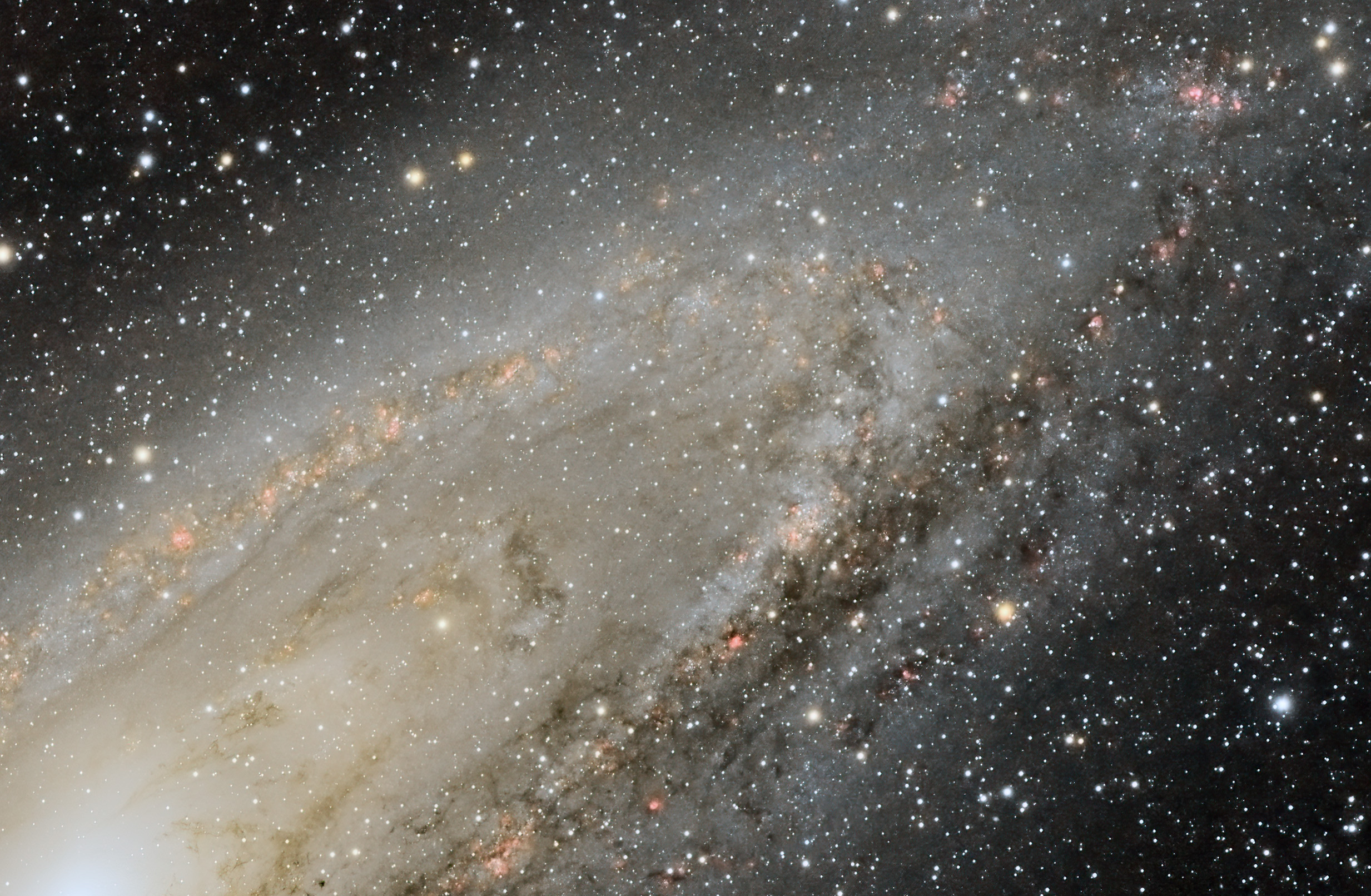Messier 31, the great galaxy in the constellation of Andromeda is one of the most photographed night-sky objects of all, probably second only to the Orion Nebula. Every few years I get an itch to image it again. Most astro-photographers like to revisit old targets once in a while, and this often happens when new telescopes and cameras have been purchased, and this is the reason why I’m having another go at this beautiful object. I showed off my new kit in my previous post.
It is often said of M31 that it is the furthest away object that can be seen with the naked eye. This is an amazing thing when you think about it! This galaxy is about 2.5 million light years away and it is the nearest large galaxy to our own Milky Way galaxy which is not too different in structure from M31 itself. In a dark, moonless sky, M31 looks like a fuzzy blob to the naked eye. Some people say they can also detect another nearby galaxy called M33 – The Triangulum Galaxy with the naked eye. I personally can’t see M33, but it is further away from us than M31 at around 2.75 million light years, so M33 really does represent the furthest thing anyone can see without optical aid of any kind. I’ve asked a lot of people if they can see M33 in a good, dark sky in the UK, but I’ve never found anyone who can, so I’m happy that those photons that left the Andromeda Galaxy when Homo habilis first walked the Earth, enter my eye and are detected by my retina represent the most ancient particles of light that can ever stimulate the human consciousness.
Here is my latest image of M31. Click on the image below to view a much larger version (4000 pixels across). Next, I will describe some more details of how this image was acquired and processed.

Firstly, what are we looking at here? The first thing to realise is that we are viewing this spiral galaxy from an angle of about 45 degrees. If we could fly over the galaxy and look directly down on it, we would see a vast spiral shape. Another thing to understand is that all of the distinct, bright stars in the image are all relatively close-by stars in our own Milky Way – in other words we are looking through a ‘curtain’ of nearby stars to see outside our own galaxy. We should understand that galaxies are vast islands of stars, separated by huge distances of near-empty space. The Andromeda Galaxy contains about a trillion stars (that’s a million, million stars) which is about twice the number in our own Milky Way galaxy. So, you are looking at all of these trillion stars in this image which are too far away to see them individually, so they glow like a huge mass.
What else can we see here? Well, you will see the dark regions in the galaxy. These are huge lanes of cosmic dust which are obscuring the light from stars behind them. Also, if you zoom in to the big image you will see the disk of red regions that glow around the galaxy. Here’s a zoomed in region that shows the red regions nicely. Each of these red areas shines be the light of Hydrogen-Alpha. All of them would be seen as nebulae to any inhabitants of planets orbiting the stars in M31 and any of them could be the equivalent of, say, the Orion Nebula that we see locally here in our region of the Milky Way.

Lastly, there is a bright elliptical blob showing below M31 in the main image. This is a dwarf elliptical galaxy called M110 which is a satellite to M31 itself. We have similar objects associated with the Milky way and they are known as the large and small Magellanic Clouds.
So, how did I create this image? I used the telescope and camera system I showed in my previous post. Over four clear nights in October 2021, I took lots of long exposure photographs of M31. The telescope was guided very accurately by the separate guide scope that was checking the guiding accuracy every 2 seconds throughout the whole time, and instructed the mount to make tiny corrections to keep the galaxy perfectly still on the chip of the sensitive camera. Eventually I had about 22 hours of exposures stored on my imaging computer. By the time I weeded out the poorer frames, I had 10 hours of data from my broadband luminance filter, and about 7 hours of data from my narrowband filter.
The narrowband filter I used was the 2″ Optolong L-Extreme filter. This passes light from both H-Alpha and Oxygen-III sources, both with a passband of 7nm wide. In this image I only wanted the H-Alpha data, so I extracted the red channel from the narrowband images and threw away the green and blue which shared the OIII signal. Then I merged the H-Alpha signal with the red channel from the broadband RGB images. This enhanced the red emission nebulae in M31 beautifully.
I’ll write a more detailed blog about my process next…
